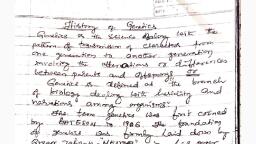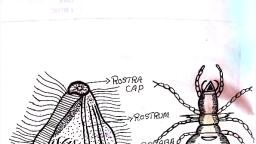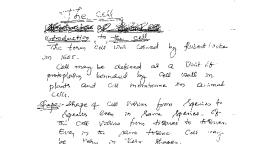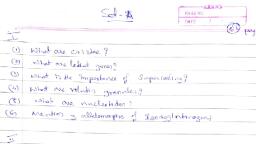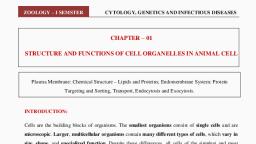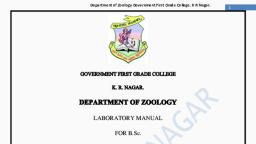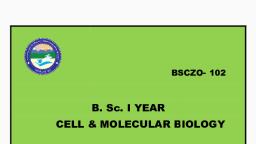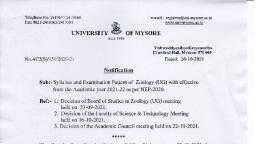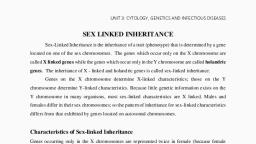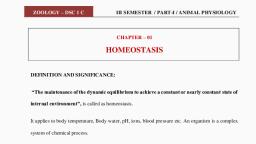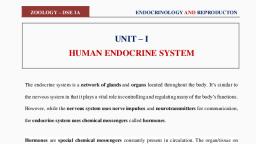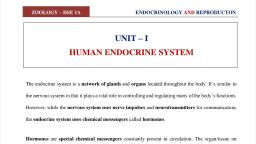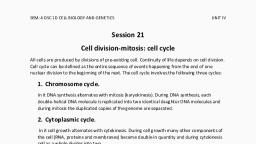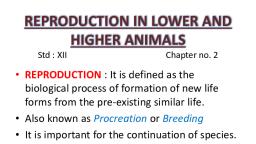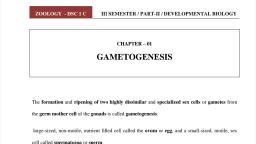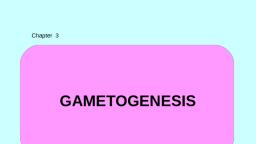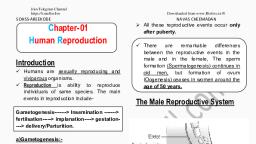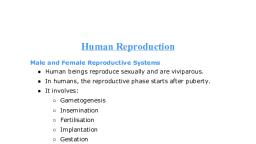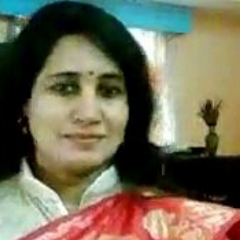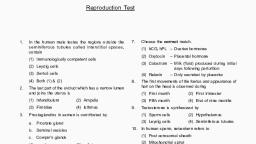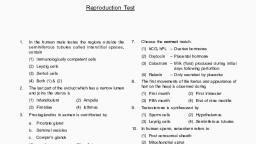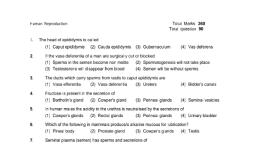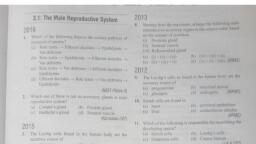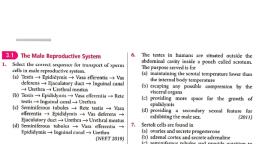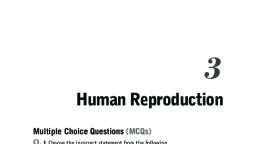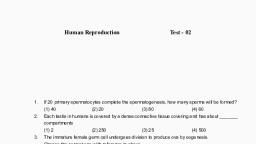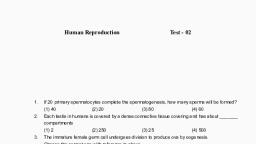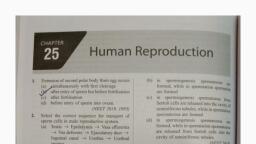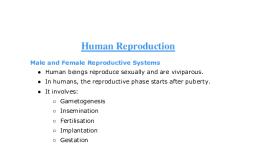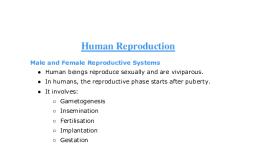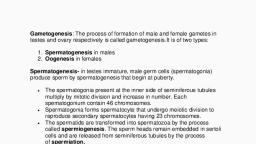Page 1 :
ZOOLOGY -DSC1C Ill SEMESTER / PART-II / DEVELOPMENTAL BIOLOGY, , , , CHAPTER - 01, , GAMETOGENESIS, , , , , , , , The formation and ripening of two highly dissimilar and specialized sex cells or gametes from, , the germ mother cell of the gonads is called gametogenesis., , large-sized, non-motile, nutrient filled cell called the ovum or egg, and a small-sized, motile, sex, , cell called spermatozoa or sperm., , The formation of spermatozoa or sperm in the male gonad — testis, called spermatogenesis;, , similarly, the formation of ova or egg cell in the female gonad — ovary, called as oogenesis., , SPERMATOGENESIS:, , Spermatogenesis takes place in the male gonads, i.e., testes. Usually testes are paired structures,, present outside the body or in the abdominal cavity. Each of the testes consist numerous tubules, called seminiferous tubules. The tubules contain different types of cells, of which the most, important types of cells are the primordial germ cells. The other cells within the tubules help to, nourish the germ cells called Sertoli cells and the interstitial cells (Leydig cells) are endocrine in, , nature and secrete male sex hormones, the androgens (testosterone)., , The spermatogenesis is a continuous process and it can be divided into two phases each, characterized by specific morphological changes of nuclear and cytoplasmic components. The two, , phases are as follows;, , A. Formation of spermatids, , B. Spermiogenesis, , , , fa LEO ANTHONY, T. / BGS FIRST GRADE COLLEGE, MYSURU-23 / 2021-22, , OCULNIEU WILET COLNOC
Page 2 :
ZOOLOGY -DSC1C Ill SEMESTER / PART-II / DEVELOPMENTAL BIOLOGY, , A. Formation of spermatids:, , , , During the formation of spermatids, each primordial germ cell undergoes three phases as, follow; multiplication phase, growth phase and maturation phase., , 1. Multiplication phase:, , During this phase the diploid primordial germ cells multiply mitotically to form large, number of cells. These cells, which are formed after repeated, , mitotic division are called, , Sperm mother cell (2n) Mitotic, , spermatogonia (sperm mother 4, cell). This stage of, spermatogenesis is _ called, , Spermatogonium (2n), , multiplication phase. This, phase is also known as, proliferation and renewal of, , Primary Spermatocyte (2n), spermatogonia., , fs, , Primary Spermatocyte (2n) Meiosis-I, , In this phase, the spermatogonia, absorb more food and increase in size ¥, and they are now called as primary _ , Spermatocytes (n). Meiosis-II, spermatocytes and the stage is called :, growth phase. The primary, spermatocytes at this stage are still %, $x, , 9 23, diploid in number. The growth phase p, eo (n), , division, , , , Multiplication phase, , 2. Growth phase:, , Growth phase, , , , Maturation phase, , Spermiogenesis, , is shorter in duration., , , , LEO ANTHONY, T. / BGS FIRST GRADE COLLEGE, MYSURU-23 / 2021-22, , OCULNIEU WILET COLNOC
Page 3 :
ZOOLOGY -DSC1C Ill SEMESTER / PART-II / DEVELOPMENTAL BIOLOGY, , 3. Maturation phase:, , Then the primary spermatocytes undergo meiotic division and this stage is called, , maturation phase., , The first meiotic division is the reduction division in which the two daughter cells get, , only haploid (n) number of chromosomes. Each daughter cell is called secondary, , spermatocyte., , The secondary spermatocytes undergo second meiotic division (which is mere mitotic, division). Thus, the resulting daughter cells retain same ‘n’ number of chromosomes and are, , called spermatids., , In this way, each primary spermatocyte gives rise to four spermatids., , Ultimately, each spermatid undergoes various changes and gives rise to a sperm. This, , process of transformation of spermatids into sperm is called spermiogenesis., , B. Spermiogenesis:, The process of transformation of spermatid (non-motile) into sperm (motile) is known as, spermiogenesis., Each spermatid consists of cytoplasm, a nucleus with the gametic chromosomal, number, a pair of centrioles, Golgi bodies, mitochondria and other cell inclusions., The process of spermiogenesis mainly involves a series of changes in nucleus, Golgi, bodies, centrioles, and mitochondria., 1. Changes in the nucleus:, v¥ The nucleus loses water from the nuclear sap and the chromosomes become, short and compact., ¥ RNA and other proteins become scarce in the nucleus and only the DNA, , concentrates in the nucleus., , , , LEO ANTHONY, T. / BGS FIRST GRADE COLLEGE, MYSURU-23 / 2021-22, , OCULNIEU WILET COLNOC
Page 4 :
ZOOLOGY -DSC1C Ill SEMESTER / PART-II / DEVELOPMENTAL BIOLOGY, , Y Thus the shape of the nucleus becomes elongated and narrow., , Y This has a functional significance that it reduces the weight and thus facilitates, increased motility of the sperm., , 2. Changes in the Golgi bodies (formation of acrosome):, , ¥ The acrosome of the sperm is derived from the Golgi bodies which are, arranged around small vacuoles., , Y One or more vacuoles begin to enlarge and a dense body formed inside the, vacuole. The dense body is called pro-acrosomal granule., , vY All the pro-acrosomal granules fuse together, further increase in size and now it, is termed as acrosomal granule, which forms the core of the acrosome., , vY The vacuole loses water and its wall spreads out covering the front half of the, nucleus and acrosome. This is the head cap or acrosomal cap of the nucleus., , 3. Changes in the centrioles (formation of the tail):, , ¥ The spermatid consists two centrioles, and they move behind the sperm, nucleus., , YA depression is formed in the posterior surface of the nucleus and one of the, two centrioles is placed in the depression. This is the proximal centriole (upper), of the spermatozoa; the other centriole, the distal centriole (below)., , Y The distal centriole now, gives rise to the axial filament of the flagellum (tail), of the spermatozoa. Thus the region between the two centrioles forms the middle, piece., , 4. Changes in the mitochondria:, , Y Most of the mitochondria of spermatid concentrate around the distal, centriole and upper part of the axial filament., , vIn the mid-piece of sperm, the mitochondria lose their individuality by fusing to, , become spirally arranged mitochondrial bodies., , , , LEO ANTHONY, T. / BGS FIRST GRADE COLLEGE, MYSURU-23 / 2021-22, , OCULNIEU WILET COLNOC
Page 5 :
ZOOLOGY -DSC1C Ill SEMESTER / PART-II / DEVELOPMENTAL BIOLOGY, , Thus, much of the cytoplasmic fluid content become reduced, shape of the cell become, narrow and finally with all changes a non-motile spermatids gain the power of motility, , become a functional motile, mature sperm., , Golgi, apparatus, , Acrosomal, vesicle, , , , , , Mitochondria, , , , , , @, Spermatid |, ‘ucleus @ Microtubules, (a) Flagellum—~, @ |, OOGENESIS:, , The process of formation of egg or ovum in the ovary is called oogenesis. An egg acquires its, developmental potential during oogenesis. The eggs or ova are formed in the ovary. The first cells, , which give rise to the mass of the ovary are called primordial germ cells., , The oogenesis process takes place by three phases; multiplication phase, growth phase and, , maturation phase., , 1. Multiplication phase:, Each primordial germ cell undergoes repeated mitotic divisions and gives rise to the, cells called oogonia (egg mother cells). This period is called as the multiplication, , phase of oogenesis., , , , LEO ANTHONY, T./ BGS FIRST GRADE COLLEGE, MYSURU-23 / 2021-22, , OCULNIEU WILET COLNOC

